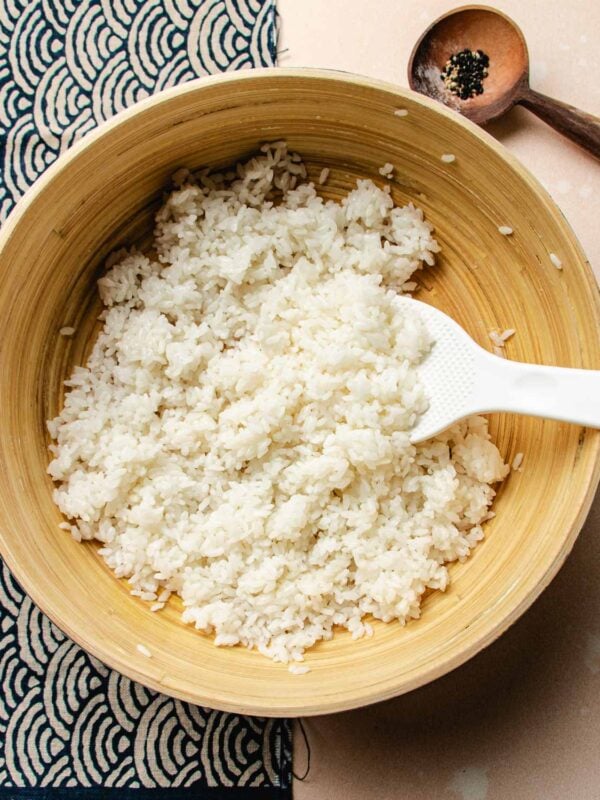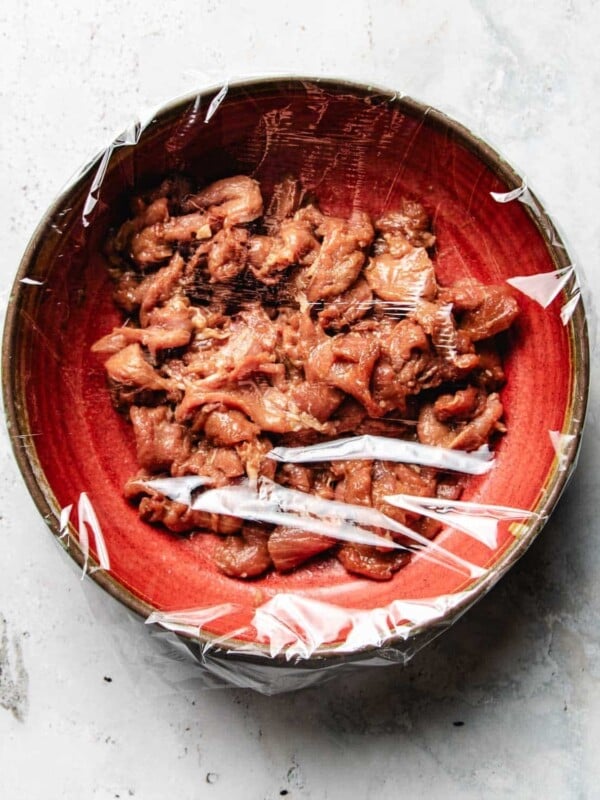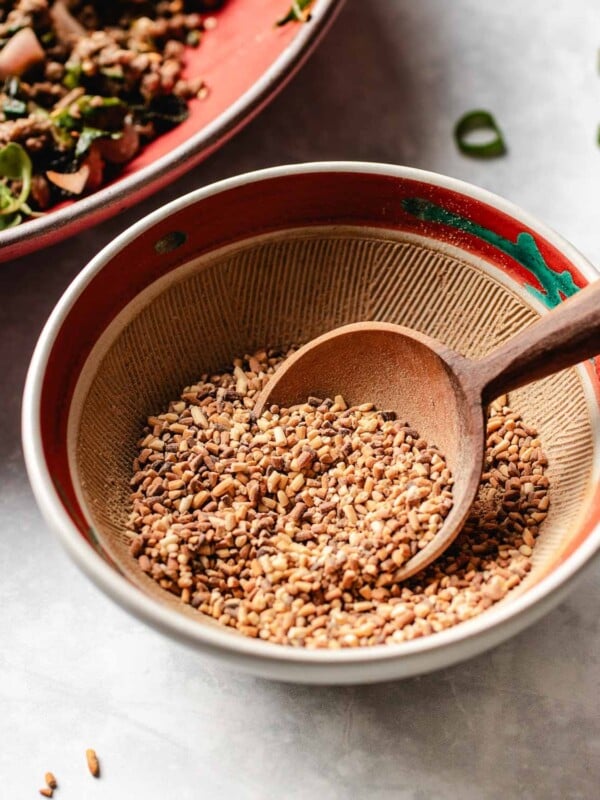This post may contain affiliate links. Please read our disclosure policy.
How to cook rice in a rice cooker is a game-changer for anyone looking to simplify their cooking routine. With just a few simple steps, you can have perfectly cooked rice every time—no more guessing games or overcooked grains.
In this guide, we’ll walk you through everything you need to know, from choosing the right type of rice to troubleshooting common issues. By the end, you’ll be a rice-cooking pro, ready to serve up fluffy, delicious rice with confidence!

Table of Contents
Why use a rice cooker
Cooking rice can be tricky, but a rice cooker takes all the guesswork out of the process. Here’s why it’s a must-have in your kitchen:
- Convenient: Hands-free and fast.
- Perfect Results: Fail-proof cooking every time.
- Easy Measurements: Water level indicators in the inner pot make it simple.
A rice cooker saves you time and guarantees perfect rice every time. No more worrying about mushy or hard grains—your rice comes out moist, soft, and slightly chewy with a beautiful translucent center. It’s the easiest way to get delicious, consistent results with minimal effort.
Rice cooker cup vs. U.S. measuring cup
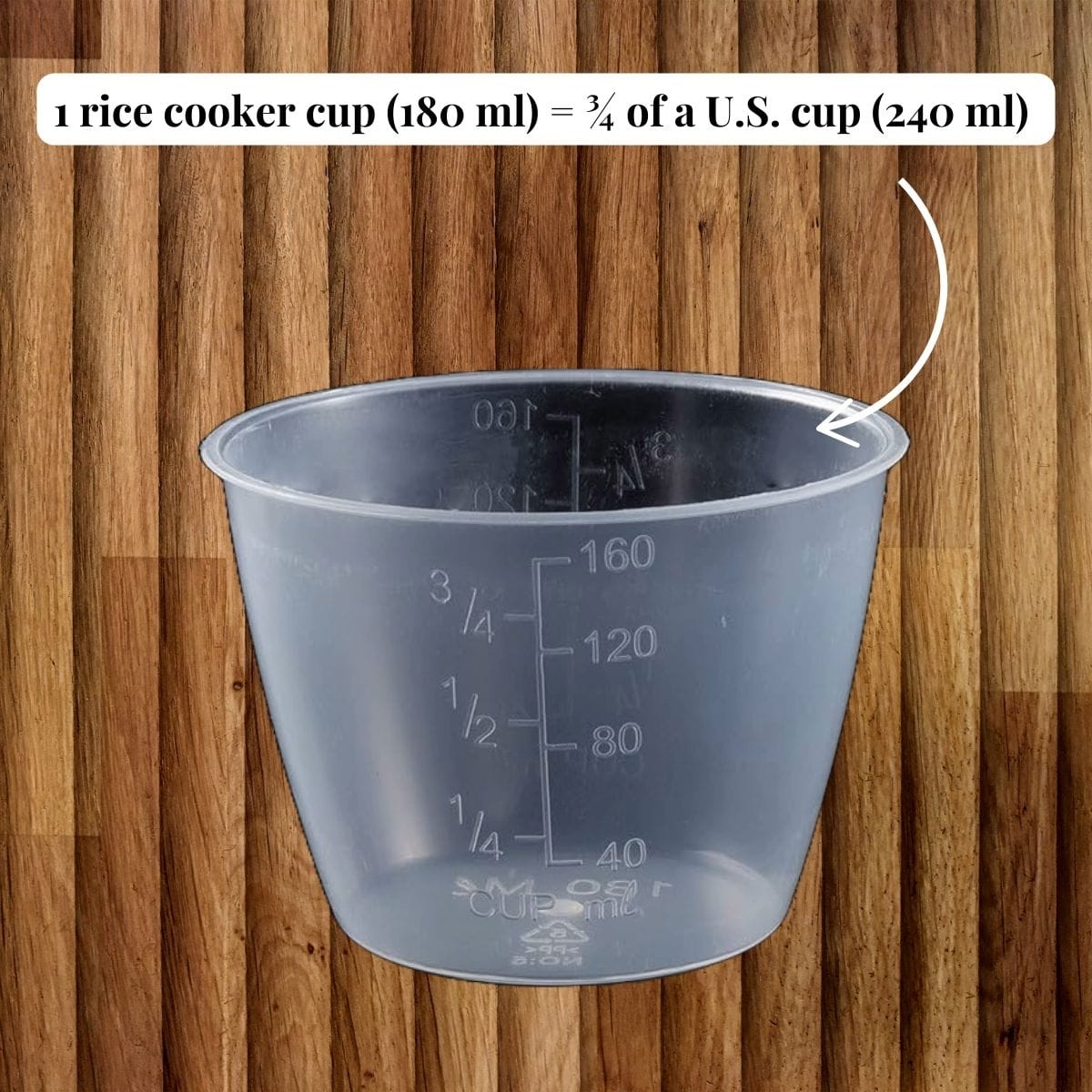
Save This Recipe
Every rice cooker comes with its own measuring cup, but don’t assume it’s the same as a U.S. measuring cup. In fact,
1 rice cooker cup (180 ml) equals ¾ of a U.S. cup (240 ml).
This difference matters because the rice cooker cup is smaller than a standard U.S. measuring cup. So, whenever we mention “cups” of rice here, we’re talking about the rice cooker cup.
For convenience, I highly recommend using the rice cooker cup that comes with your cooker.
Types of rice to use
In general, the longer the grain, the more water it needs to cook. Personally, I prefer short grain white rice and my go-to brands are Tamaki Gold and Shirakiku rice. Here’s a quick guide to the different types:
- Short Grain White Rice:
- Type: Japonica rice, sushi rice (like Koshihikari), Taiwanese pon-lai rice, Korean short grain rice.
- Taste: These grains are short and round, with a starchy texture. They turn soft, sticky, and springy when cooked—perfect for sushi and dishes where you want the rice to clump together.
- Medium Grain White Rice:
- Type: Nishiki rice, Calrose rice from California, Japanese or Korean glutinous rice.
- Taste: Moist, tender, and slightly chewy when cooked. These grains have a bit more bite than short grain but are still soft and comforting.
- Long Grain White Rice:
- Type: Jasmine rice, Thai glutinous rice.
- Taste: Light, fluffy, and less starchy. Jasmine rice, in particular, is perfect for fried rice, as the grains stay separate and airy.
Note: Glutinous rice requires a different water ratio. Check out our guides on How to Cook Sticky Rice in a Rice Cooker or Microwave Sticky Rice for more details.
For other types of rice grains, see How to Cook Brown Rice in a Rice Cooker, Basmati Rice in a Rice Cooker, and Sushi Rice in a Rice Cooker.
Rinsing the rice?
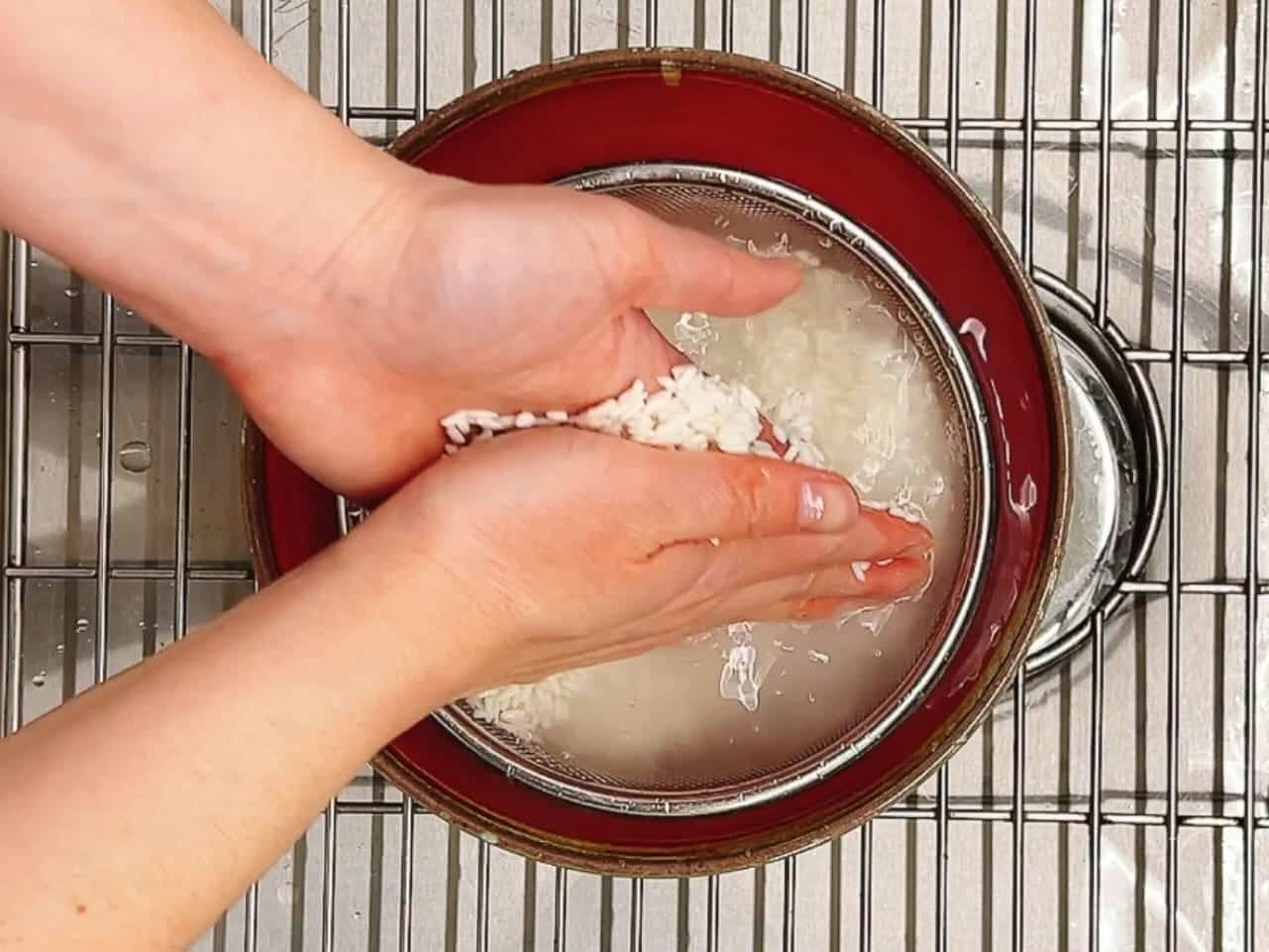
To rinse or not to rinse? It’s really a personal choice and can depend on the brand of rice you use.
In general, I recommend rinsing the rice. Measure the amount you need, pour it into a fine mesh strainer over a bowl, and swish it under tap water 2-3 times to rinse off excess starch. Shake off the excess moisture, then add the rice to the cooker.
When in doubt, check the instructions on the back of your rice packaging—they often have specific recommendations based on the type of grain.
How to use rice cooker (step-by-step guide)
Cooking rice in a rice cooker is a simple, hands-free process that guarantees perfect results every time. Follow these steps to get the most out of your rice cooker:
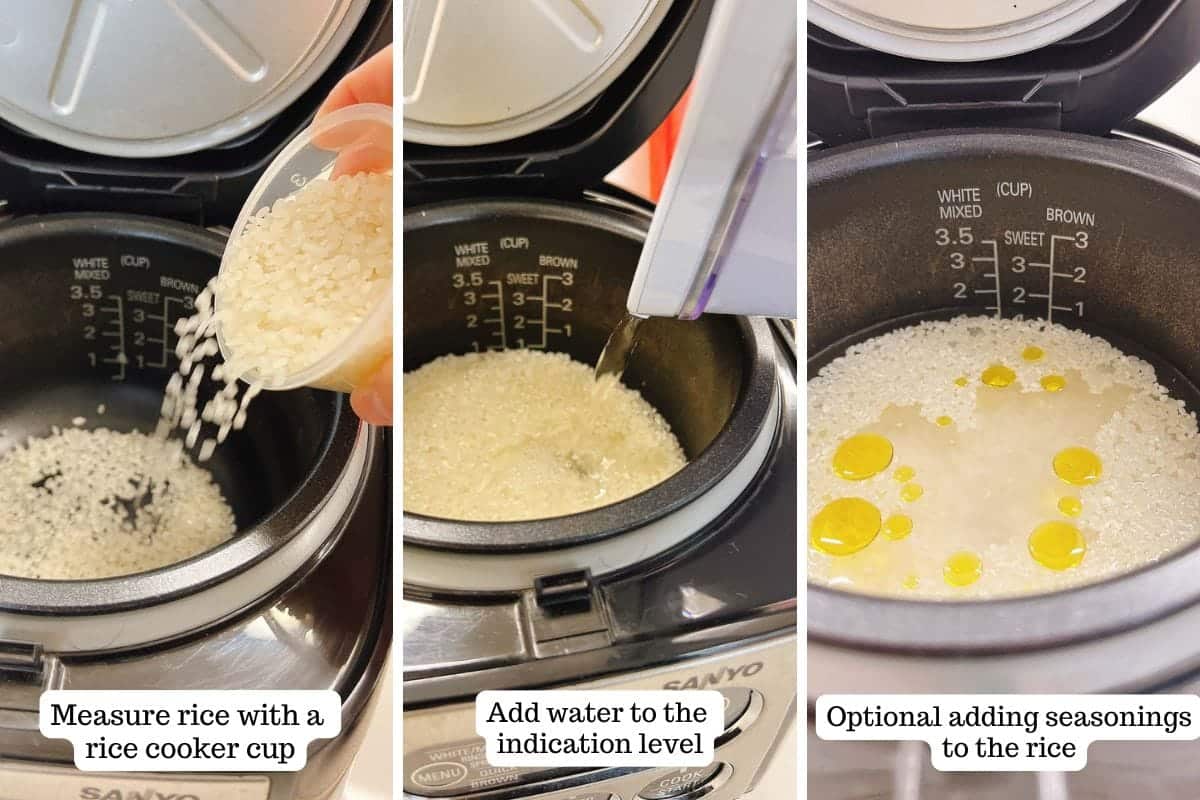
- Measuring the Rice:
- Start by deciding how much rice you need. Generally, 1 rice cooker cup is enough for 2 servings.
- For best results, use at least 1.5 to 2 rice cooker cups of rice.
- White Rice to Water Ratio:
- Check the inner pot of your rice cooker for water level markings, which guide how much water to add based on the type of rice you’re using. For white rice, the typical ratio is 1 rice cooker cup of rice (180 ml) to 200 ml of water.
- Add the rinsed rice to the inner pot, level it out, pour in room temperature water up to the indicator line, close the lid, and press “Cook.”
- How Long Does a Rice Cooker Take?
- The cooking time varies depending on the amount of rice, but generally, it takes about 30-40 minutes, plus an additional 15 minutes of resting time.
- After pressing start, resist the urge to open the lid, as this can affect the cooking process.
- Resting Time:
- Once the rice cooker beeps, signaling it’s done, don’t open the lid just yet. Let the rice rest for 10-15 minutes. This resting period allows the rice to finish steaming and settle perfectly.
- Fluff, Don’t Smash:
- When it’s time to serve, always use a rice paddle to fluff the rice. Scoop from the bottom up to gently separate the grains. Avoid using a fork, as it could scratch the inner pot’s coating.
How long can you leave rice in a rice cooker?
For the best quality, you can leave rice in the rice cooker for up to 3 hours.
If you’re storing it at room temperature, the duration depends on the season:
- Summer: Up to 6 hours
- Winter: Up to 1 day
Trouble shoot
Too Wet:
- Leave the rice cooker open for 10-15 minutes to let excess moisture escape. If the rice is only slightly wet, it will firm up as it cools. If the grains are very soft and mushy, reduce the water next time.
- To salvage overly soft rice, cool it to room temperature, then store it in the fridge. Once chilled, use it to make dishes like a Spicy Tuna Bowl with crispy rice or Crispy Rice Sushi.
Too Dry:
- The bottom of the rice tends to cook faster than the top. To fix dry rice, quickly use a rice paddle to fluff the rice from the bottom up. Stir in 2 tablespoons of hot water (up to 4 tablespoons if the rice is really hard), close the lid, and let the rice absorb the moisture for 15 minutes before checking again.
Rice cooker ratio reference chart
In general, use this simple water to rice ratio formula:
1 rice cooker cup of dry rice (180 ml) x 1.1 = 200 ml of water (room temperature).
Here’s a quick reference chart for short grain, medium grain, and long grain white rice:
- 1 rice cooker cup (180 ml) : add 200 ml or ⅞ U.S. cup of water
- 2 rice cooker cups (360 ml) : add 400 ml or 1⅔ U.S. cups of water
- 3 rice cooker cups (540 ml) : 600 ml or 2½ U.S. cups
- 4 rice cooker cups (720 ml) : 800 ml or 3⅓ U.S. cups
- 5 rice cooker cups (900 ml) : 1000 ml or 4¼ U.S. cups
TIP: You can use the same rice-to-water ratio for Aroma rice cookers.
Rice seasoning options
Steamed rice is typically kept neutral in flavor to complement savory dishes and balance out salty flavors. But if you want to give your rice an extra boost, here are a few ideas:
Before Cooking:
- To enhance the flavor of your rice right from the start, try adding a few pinches of salt and a drizzle of olive oil to the inner pot before cooking. This simple step can make a big difference.
After Cooking:
- Once the rice is cooked, you can mix it with a few teaspoons of garlic chili sauce for a spicy, savory kick, or Taiwanese Shacha sauce for a rich umami flavor.
Rice Seasonings:
- For an easy way to jazz up your rice, check out the rice seasonings available at many Asian grocery stores or online. Japanese seasonings like furikake come in a variety of flavors and ingredients, making your rice more interesting. My favorite is from Muso.
How to store cooked rice
In the Fridge:
- Let the rice cool to room temperature before storing it in the fridge. It can be kept for up to 3 days. When reheating, place the rice in a microwavable container, cover it loosely, and microwave until the rice is soft and chewy again.
In the Freezer:
- For longer storage, freeze the rice for up to 1 month. To reheat, sprinkle a little water over the rice, place it in a loosely covered microwavable container, and microwave until it returns to its soft and chewy texture.
Cleaning your rice cooker
- Inner Pot: The inner pot of your rice cooker, often made with titanium, is the only part that can be soaked in water. To clean it, soak the pot briefly in warm water with mild dish soap. Then, use a soft, non-abrasive cloth to gently clean it.
- Follow the Manual: Always refer to your rice cooker’s manual for specific cleaning instructions. It usually includes tips on how to take apart and clean various components easily.
- Keep It Dry: After cleaning, make sure all parts of the rice cooker are thoroughly dried to prevent any musty smells. Store the appliance in a dry place, away from moisture, to keep it in good condition.
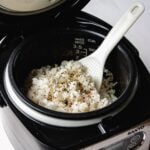
How to cook rice in a rice cooker
Ingredients
- 1.5 to 2 rice cooker cup white rice, short grain, medium grain, or long grain
- Water, amount based on rice cooker markings or 200 ml per 1 rice cooker cup of rice
Equipment
- Electric rice cooker Toshiba or Zojirushi
Instructions
- Measure the rice: Use 1.5 to 2 rice cooker cups of rice for 3-4 servings.
- Rinse the rice: Place the measured rice in a fine mesh strainer and rinse under tap water 2-3 times. Shake off excess moisture.
- Add rice and water: Transfer the rinsed rice to the rice cooker. Level the rice, then add room temperature water up to the appropriate indicator level in your rice cooker's inner pot. For more precision, use 200 ml water per 1 rice cooker cup of rice.
- Cook the rice: Close the lid and press the "Cook" button. The cooking time is generally 30-40 minutes, plus an additional 15 minutes of resting time.
- Rest the rice: Once the rice cooker beeps, do not open the lid. Let the rice rest for 10-15 minutes.
- Fluff the rice: Use a rice paddle to gently fluff the rice by scooping from the bottom up. Avoid using a fork to prevent scratching the inner pot.
Notes
- Rice cooker cup vs. U.S. measuring cup: A rice cooker cup (180 ml) is smaller than a U.S. measuring cup (240 ml). Keep this in mind when following recipes to ensure you get the correct water-to-rice ratio.
- Rice cooker ratio: 1 rice cooker cup of dry rice (180 ml) x 1.1 = 200 ml of water (room temperature).
- 1 rice cooker cup (180 ml) : add 200 ml or ⅞ U.S. cup of water
- 2 rice cooker cups (360 ml) : add 400 ml or 1⅔ U.S. cups of water
- 3 rice cooker cups (540 ml) : 600 ml or 2½ U.S. cups
- 4 rice cooker cups (720 ml) : 800 ml or 3⅓ U.S. cups
- 5 rice cooker cups (900 ml) : 1000 ml or 4¼ U.S. cups
- To rinse or not to rinse the rice? Rinsing rice is generally recommended to remove excess starch and prevent the rice from becoming too sticky or gummy. However, it’s a personal choice and can vary depending on the type and brand of rice.
- For best results, use at least 1.5 to 2 rice cooker cups of rice.
- My personal favorite white rice brands are: Tamaki Gold and Shirakiku rice.
- Note: Glutinous rice (sticky rice) requires a different water ratio. See our guide on How to Cook Sticky Rice in a Rice Cooker or Microwave Sticky Rice for detailed instructions.
Made a dish and loved it? Please rate the recipe and leave a comment in the section below! It helps my blog grow organically, allowing me to continue sharing free and awesome content with you. Thank you!
